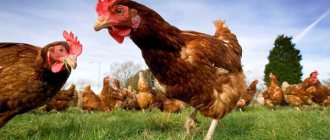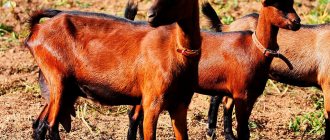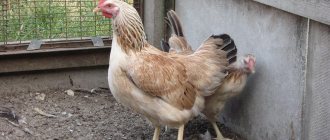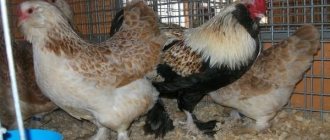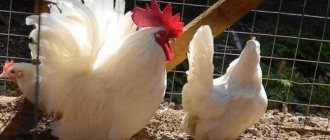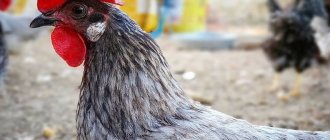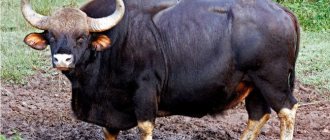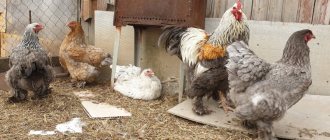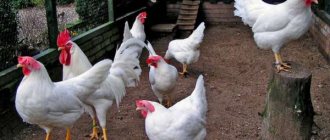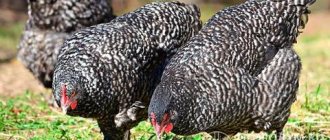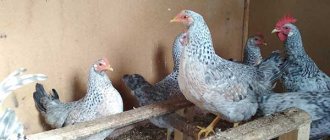Poultry farming » Chickens
0
1830
Article rating
Kira Stoletova
As a result of crossing meat-egg crosses, breeders from the UAAN and the Borki Research Institute managed to obtain a good breeding herd. The newly bred breed of Hercules chickens have good body weight, egg production and are characterized by rapid growth of young animals. Thanks to these qualities, the breed has become widespread throughout Russia.
Chickens of the Hercules breed
Breed characteristics
The description includes several distinctive qualities:
- head of medium size, rounded;
- orange eyes;
- the beak is yellow, slightly curved at the tip;
- comb scarlet, leaf-shaped, divided into 4-6 teeth, erect;
- earrings and earlobes are red;
- the tail is small in size, in roosters with long hanging feathers;
- the legs are stocky and yellow;
- It has a strong and massive frame with a wide back and chest.
The plumage is varied, combining several tones - white, black-striped, golden, silver and pockmarked.
Today, Hercules chickens are one of the most common breeds in Ukraine and other CIS countries.
Temperament
The bird has a calm and peaceful disposition. Chickens treat young animals well. Roosters do not show aggression towards the owner and representatives of other breeds, therefore they are allowed to be kept together in the same flock.
Productivity indicators
Almost all breeders note the high productivity of chickens. This breed is characterized by the following productivity indicators:
- egg production - from 210 to 220 eggs per year;
- at one year of age, the male, like broilers, reaches 4.2-4.5 kg in weight, the female about 3.4 kg;
- large eggs - average weight from 65 to 70 g;
- puberty and readiness for egg laying occurs at 5-6 months of breeding;
- young animals have a good survival rate - up to 92%, adults - 93-94%.
Price
The price for this breed is quite high - day-old chicks cost from 40 to 50 rubles, grown-up young animals cost 60-100 rubles.
Despite such a high price, the birds quickly recoup the investment - with intensive weight gain and the ability to lay eggs already at the age of five months.
Adults cost from 1200 to 1500 rubles.
Feeding
Chickens of the Hercules breed, according to reviews, need rationed feeding - birds are prone to obesity. Laying hens are given mixed feed intended for meat and egg breeds - they follow age/standard recommendations. Roosters fattened for meat should receive broiler feed with a crude protein level of 21% - it is also important to take into account feeding standards. When preparing your own diet, food is prepared from:
- crushed corn grains – 20%;
- wheat – 30%;
- barley – 10%;
- peas – 5%;
- meal and cake – 8%;
- meat and bone meal – 4%;
- chalk – 8%;
- crushed shell – 2%;
- feed yeast – 2.5%;
- herbal flour – 2.5%;
- salts – 0.1%;
- premix – the remaining amount.
Additional nutritional components: vegetables, fruit peelings, fresh table waste, greens, meat and fish waste. Feed costs for an increase in 1 kg of live weight are 2.3-2.4 kg. Before laying eggs, each hen eats up to 9.5 kg of feed.
Advantages and disadvantages
Characteristics of the Hercules breed include several important advantages for poultry farmers:
- like broilers, they quickly gain weight;
- calm and peaceful disposition;
- excellent taste of eggs and meat;
- high resistance to many diseases and parasites;
- good tolerance to sudden changes in temperature and humidity;
- the eggs are large, contain large yolks (occupying 35% of the weight).
One of the disadvantages is that birds of the second and third generation are less productive than their parents.
Origin story
Year of creation: 2000. Homeland: Ukraine, Kharkov. The Hercules breed is crosses. Selection work was carried out by scientists under the leadership of Professor Yu.A. Bondarenko. at the Institute of Poultry Science. Work on the creation of these birds lasted about ten years. Hercules combines the gene pool of Ukrainian and foreign birds.
The birds got their name due to their considerable size and high productivity. Although the breed is not even two decades old, it is already famous among poultry farmers.
Features of care and maintenance
Very stress-resistant chickens
One of the main advantages of the breed is its excellent adaptive properties. The bird easily tolerates stressful situations and sudden temperature changes without reducing productivity.
Chicken coop
Given its large size, this breed requires a lot of space in the house - at least 50 m³ per individual. Chickens do not need roosts, because... due to their heavy weight, they will not be able to take off on them.
Before introducing livestock into the premises, it must be carefully prepared:
- clean the remaining debris, whiten the walls and floor surfaces with slaked lime to destroy all bacteria and microbes;
- the bottom can be sewn up with boards or tin, covering all the cracks and access to rodents;
- the floor is covered with a thick layer of hay, straw or sawdust - 40 cm in the winter, 10-15 cm in the summer;
- the litter is laid on a warm and sunny day so that it remains dry;
- nests are made indoors for laying hens in a quiet place inaccessible to roosters and other individuals;
- place feeders and drinkers at the rate of 4 and 3 cm for each individual, respectively;
- Additionally, install a basin or other container for bathing, fill it with dried clay, sand or ash.
To protect against diseases and parasites, you need to maintain stable heat - 23-25°C in winter, about 13°C in summer. Regular ventilation will ensure an optimal microclimate in the chicken coop. To do this, open windows or doors every day.
Diet
The health of birds and their productivity largely depends on feeding.
- Throughout the year, chickens are given mixed feed, which forms the basis of daily feeding at the rate of 120-130 g per individual. You can purchase a ready-made composition or prepare it yourself by mixing mineral additives, fish and meat and bone meal, sunflower meal, crushed wheat, corn in a ratio of 1:1:1:3:4.
- In the winter season, nutrition should be enhanced due to a lack of vitamins and minerals. In the chicken coop, separate containers with shells, pieces of chalk, meat and bone and fish meal are installed. Every day they give a mash of boiled and grated root vegetables, fruits, and vegetables. Scatter chopped cabbage and beets. They are fed with sprouted grain crops (wheat, rye, oats). Add fish oil, vitamins and minerals.
- In the summer, when the bird has the opportunity to freely walk outside, it feeds on fresh herbs. At the farmstead, chickens are fed nettles, clover, green peas, and dandelion. They also scatter pieces of chalk and shells.
- It is imperative to give sifted sand every day, which helps get rid of food residues and prevents blockage of the crop and the development of various diseases.
- To compensate for the lack of protein in the cold season, poultry are given steamed legumes - peas, beans, beans.
In addition to proper feeding, fresh water is required. The water is changed daily, served at room temperature in winter and cold in summer.
Walking yard
Hens and cockerels with a decent weight rarely take off, so the walking area is fenced off with a low fence. The top of the enclosure does not need to be covered with a net. The optimal space for one individual is 2-3 m².
In the spring they are sown with grass so that there is fresh greenery closer to summer. In winter, you can make a slate shelter at the walking site - this way the bird can walk all year round and peck at the leftover food.
Molting and break in egg production
Molting is a traditional procedure for every breed of domestic chicken. The bird begins to shed feathers en masse, loses its decorative qualities and stops laying eggs.
Complete restoration of feather cover occurs after 1-1.5 months.
For quick recovery, foods with a high protein content are added to the food - meat or fish broth.
Herd replacement
Planned replacement of old hens with pullets is carried out after a decrease in egg production - usually this happens in the 3rd or 4th year of keeping.
The pullets are released into the general herd, and the old hens are sent to slaughter.
Breeders reviews
According to those who breed chickens, this breed is truly unique. First of all, because it is unpretentious in care, grows quickly, has juicy meat, and the second generation continues to retain all these properties. Increased egg production is a big plus that breeders mention. Owners of chickens of this breed recommend keeping roosters that they plan to slaughter in a separate room. Judging by the reviews, there is information that even with a small amount of food, males still gain weight.
Breeders are also pleased with the nature of the birds, which are easy-going. According to reviews, white chickens of this breed are slightly larger than multi-colored ones. Poultry farmers are also pleased with the cream-colored eggs with an excellent, bright yolk. They are larger in size than usual, which attracts both buyers who want to eat fresh eggs and the owners themselves.
Breeding rules
Excellent hens
Chickens of this breed have a good brooding instinct, but only the first offspring is able to adopt all the qualities of its parents.
With further crossing, only 25% of all characteristics are transferred, so breeders breed this bird using the incubation method.
Incubation
To obtain healthy and strong chicks without defects and pathologies, you need to choose high-quality material:
- take eggs no older than five days old, medium in size with a smooth surface, without cracks;
- You should not use specimens that are too blunt or pointed for breeding, because chicks with pathologies may appear from them;
- eggs are laid unwashed.
Set the temperature at 40°C, and every 7 days it is lowered by 1°C. During incubation, specimens must be turned 3-4 times to ensure uniform heating.
The chicks hatch 20-21 days after the eggs are laid.
Care
The young offspring are placed in a cardboard or wooden box covered with straw, sawdust or a rag. An IR lamp is installed on top at a distance of 50 cm. Such lighting will provide an optimal microclimate for the chicks.
Caring for chickens of this breed is no different from the rules for keeping other chicks. The most dangerous age is up to 3 weeks, when the young can wither and die. Later, when the chicks get stronger, the risk of death is minimal.
Conditions of detention:
- on the first day to dry the gun, the temperature is provided at 31-32° using an IR lamp, then every day it is reduced by 2-3°C, bringing the indicator to 19°C;
- after 2 weeks of care at home, the chicks are taken outside on sunny days - such walks have a beneficial effect on health;
- At one and a half months, the grown young animals are transferred to the general herd.
Feeding
In the first days of life, a boiled and finely chopped chicken egg is offered. Starting from the third day, it is mixed with green onions, small cereals and low-fat cottage cheese. On days 20-21, the food is made more varied - sunflower cake or crushed seeds are added.
A month later, dandelion, carrot tops, clover, and nettle are mixed into the food. These plants have a good effect on the digestive system of chicks.
All supplied grain mixtures are prohibited from steaming - after heat treatment they lose useful components.
You should not give food rich in fiber and flour, because... they can cause blockage of the goiter.
Day-old chicks are fed a glucose solution - 50 g per 1 liter of water. Later give clean water at room temperature.
Incubation
To produce offspring, hens are crossed with Cornish roosters. For incubation, eggs weighing about 70 grams are chosen - smaller ones produce defective offspring. Incubation temperature is from 38.3 to 37.2 o depending on the incubation day. The eggs are selected to be the same size, without cracks or chips.
Table of temperature and humidity modes
| Period |
